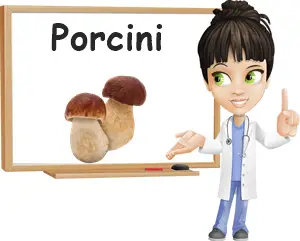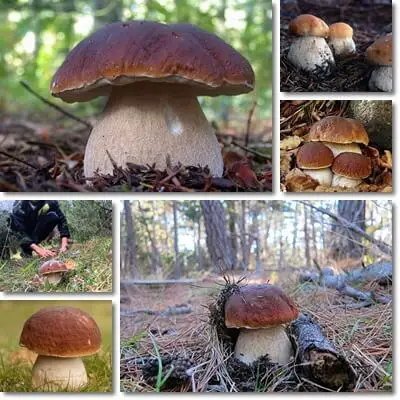Porcini mushrooms, identified by the scientific name Boletus edulis, are a species of wild edible mushroom and a delicacy second only to truffles. The species goes by many common names, including cep, cepe, penny bun, bolete and ‘fungo porcino’. Porcini are a source of good nutrition, providing important micro-elements such as vitamin D2, copper, selenium and zinc, but also antioxidants, dietary fiber and protein with varied health benefits. At the same time, they can be a source of side effects such as digestive discomfort and pose a risk of heavy metal contamination if intake is excessive.
What do porcini mushrooms look like? Porcini mushrooms of the Boletus edulis species have a rather thickset appearance. The cap is thick, meaty, typically rounded or umbrella-shaped but is known to become flattened in adult specimens. It has a reddish-brown color that gets darker as the mushroom ages and light-colored, white margins. The surface of the cap appears gooey, sticky. The underside of the cap is whitish in young mushrooms and a greenish-yellow in adult specimens. It has a spongy texture and fine holes through which the mushroom spores are released. Boletus edulis spores are a greenish-brown or olive color.

The stalk (stipe) is club-shaped, thickening towards the base; over time, as it thickens, it can become bulbous in shape, looking as if it’s swollen. It is light brown in color and marked with fine, white lines in a net-like pattern. The flesh of the stalk is white and firm, but the texture becomes somewhat spongy in adult specimens. When cut or otherwise bruised, the flesh may become tinged with a light reddish-brown. Porcini mushrooms can grow to impressive sizes: at maturity, the cap can have anywhere from 8-30 cm in diameter, while the stalk can be 8-10 cm thick and 8-25 cm long. A single porcini mushroom can easily weigh 1 kilogram, although a lot bigger, heavier specimens have been foraged.
How do porcini mushrooms taste like? Cooked porcini mushrooms have a rich taste with pleasant nutty and earthy, grassy flavors. Their distinctive aroma is on account of a faint sourdough-like or umami taste. The flesh is firm, but soft and tender, almost meat-like, with a creamy feel. The species is a particularly savory wild mushroom, not to mention a versatile food. While they are preferred fresh, dried porcini boast an even more intense aroma, with a roasted or dried seasoning-like flavor. For the best taste experience, it’s advised to choose mature, but not overly ripe mushrooms and avoid those with blemishes or that are too large or too sticky-looking.
Porcini recipe ideas. Stir-fried, lightly flavored, thinly sliced porcini retain their unique wild mushroom-savor and go great paired with blander options such as polenta, pasta or rice. Popular recipes include polenta with stir-fried porcini (with a crushed garlic sauce) or porcini in a tomato sauce (season with thyme, oregano, onion, salt), porcini pasta and risotto. Porcini sauces are creamy and rich, while grilled caps replicate the tender chewiness and flavor profile richness of meat. For a perfectly Italian recipe, there’s also porcini-stuffed ravioli or tortellini. The dried mushrooms are more intense-tasting and can be used in sauces and soups for a richer flavor.

Interesting facts
Why are porcini mushrooms (Boletus edulis) so expensive? Porcini are extremely popular, being one of the most appreciated mushrooms, a delicacy even, so there is great demand for them. However, they are foraged from the wild and in season roughly from late summer to late autumn, depending on the region and yearly weather conditions. Both the high demand and the lack of success with the cultivation of the species explain the sometimes quite peppery price. Dried or dehydrated porcini are even more expensive than fresh ones.
Do porcini mushrooms grow in the US too? Yes, they do actually. Porcini can be found in North America, Europe and Asia where they grow naturally. They have also been successfully introduced in the Southern hemisphere. An interesting fact about the species is that it develops a mutually beneficial relation with trees, exchanging nutrients and water with tree roots. This also explains the difficulty encountered when it comes to its cultivation for commercial purposes.
Look alikes
The bitter beech or scarlet-stemmed bolete (Caloboletus calopus) is similar in appearance to edible porcini mushrooms of the Boletus edulis species, but it’s not edible itself. Similarly, the whitish bolete (Caloboletus radicans) is a close look-alike of B. edulis, but not edible either. The scarletina bolete (Boletus luridiformis) is only edible when cooked, and so is the lurid bolete (Suillellus luridus). If eaten raw or undercooked, or if eaten at all, all of these species can be a source of serious side effects, including gastrointestinal upset, severe abdominal cramps, vomiting and diarrhea, and even blood in stools. Rubroboletus rhodoxanthus is just one of many poisonous mushroom species similar in appearance to porcini.
Nutritional information
Research on the nutrition of porcini mushrooms is scarce. Some of the nutritional information available is inferred from studies on the nutrition of mushrooms in general. Overall, porcini mushrooms of the Boletus edulis species are presumed to be a good source of the following micro-nutrients: B vitamins (except for vitamin B12), vitamin D (in the form of the vitamin D2 precursor ergosterol), calcium, iron, potassium, phosphorus, selenium and zinc. As for the macro-nutrient profile, the species is known for its low energetic value (low calorie content), good fiber. low fat and modest protein and carbohydrate content.
Content of vitamin and minerals in porcini mushrooms:
Selenium: between 20 and up to 70 micrograms (mcg)/gram dry weight
Vitamin D2: 2.2 micrograms/gram dry weight
Copper: 104 milligrams/kilogram dry weight
Iron: 5841 mg/kg dry weight
Molybdenum: 0.5 mg/kg dry weight (trace amounts)
Zinc: 186 mg/kg dry weight
See: Multielemental Speciation Analysis of Fungi Porcini ( Boletus edulis ) Mushroom by Size Exclusion Liquid Chromatography with Sequential On-line UV-ICP-MS Detection. By Wuilloud, R.G., Kannamkumarath, S.S., Caruso, J.A.
Health benefits
The benefits of porcini mushrooms are a direct result of their nutritional status and include:
1) Source of protein and dietary fiber – satiating and filling, help curb hunger.
2) Potential benefits for weight loss as a result of a low energetic value (low calorie content).
3) Improved transit time, constipation relief and possibly prebiotic benefits from fiber content.
4) Immune system stimulating properties from vitamin D2.
5) Cardiovascular benefits from potassium and dietary fiber.
6) Source of complete protein (contains all essential amino acids, albeit in trace amounts) – good for muscles and the nervous system.
7) Antioxidant and anticancer properties from biologically active constituents (studies on colon cancer cell lines).
See: New insights into the molecular mechanism of Boletus edulis ribonucleic acid fraction (BE3) concerning antiproliferative activity on human colon cancer cells. By Lemieszek MK, Ribeiro M, Marques G, Nunes FM, Pożarowski P, Rzeski W).
Side effects and contraindications
1) Potential for allergic reactions. Although low, there is a risk of allergic reactions following consumption of porcini mushroom. Symptoms may include hives, throat itching, throat or tongue swelling, coughing, wheezing, difficulty breathing, low blood pressure, fainting and anaphylactic shock. It is advised to seek medical help immediately if you suspect an allergic reaction.
2) Heavy metal contamination. Porcini, and other mushrooms too, accumulate heavy metals from the surrounding environment. Studies have found mercury, cobalt, cadmium, but also radioactive metals in collected porcini specimens. It’s advised to avoid collecting mushrooms near industrial areas, active or not, or roadsides. Just as important, intake is best kept reasonable and infrequent.
3) Contamination with other mushrooms. Dried porcini are a prized delicacy. In addition to increased shelf life, drying also alters the aromatic profile of the mushrooms and intensifies their flavor. At the same time, it makes identification difficult. Dried porcini imported from China have been found to contain other species of mushrooms, albeit edible.
4) Confusion with inedible species. While plenty of porcini species are edible, there is always the risk of confusing them with inedible or even poisonous mushrooms, related or not. To avoid side effects such as severe gastrointestinal upset (severe vomiting, diarrhea, dehydration) and more serious health risks, avoid foraging and purchase your mushrooms from the supermarket or places that can offer clear identification of the species and a guarantee of edibility.
